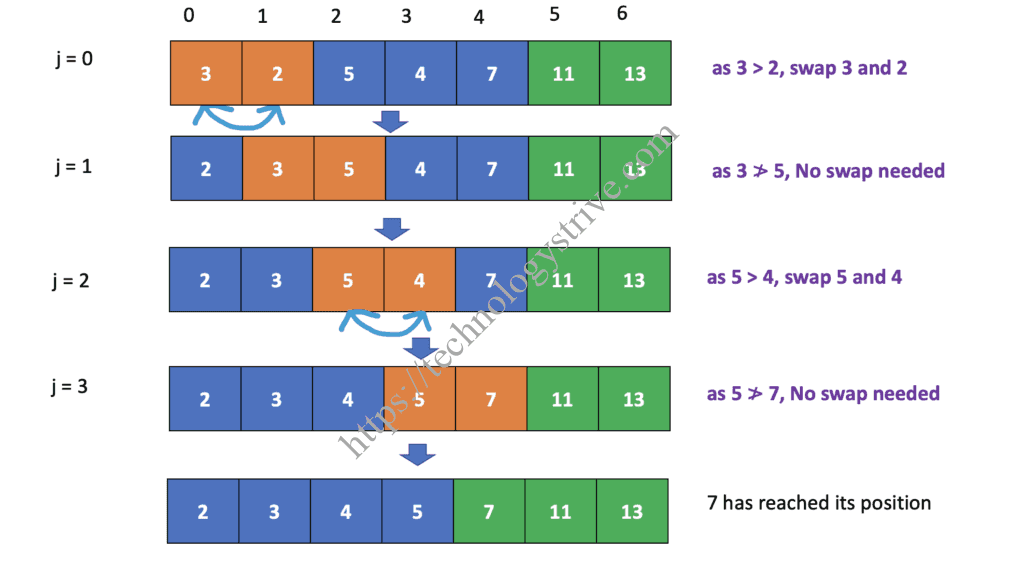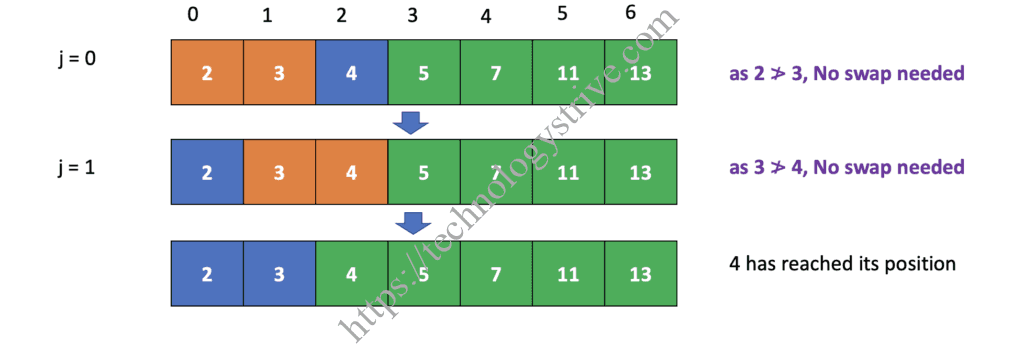
Bubble Sort Algorithm
Introduction
Bubble Sort is the easiest sorting algorithm in which adjacent elements are compared with each other and swapped if the elements are not in proper order. This process repeatedly scans the elements of the list and each iteration one element will be placed at the correct position starting with the first max element, second max element and so on.
Algorithm
1Step 0 : Initialize n to length of the array23Step 1 : Initialize j to 0 and compare a[j] with a[j+1]4 (Compare adjacent elements starting from 0th index)56Step 2 : if a[j] > a[j+1] swap a[j] and a[j+1]78Step 3 : repeat steps 1 and 2 until j reached end of the array9 (By end of this one element will be placed at its correct order)1011Step 4 : continue from Step 1 n-1 times12 (So that all elements will be in proper order)
Example Explanation
Input array : a = [5, 3, 13, 2, 11, 4, 7]
Iteration 1 :
Step 1 : Initialize j = 0 & compare first element (a[0]) and second element (a[1])
Step 2 : As a[j] > a[j+1] , swap a[j] and a[j+1]
Step 3 : Increment j and continue Step 2 until we reach the end of the array.
At the end of iteration 1, the max element will be placed at the last index of the array. We continue the same process n-1 times for the remaining unsorted array.
Iteration 2 :
Iteration 3 :
Iteration 4 :
Iteration 5 :
Iteration 6 :
Code Implementation
1public class BubbleSort {23 // Method to sort a given array4 public void sort(int[] array){5 int n = array.length;67 //loop through elements of the array8 for(int i=0;i<n-1;i++){910 // loop to compare elements of the array11 for(int j=0;j<n-i-1;j++){1213 // compare adjacent elements14 if(array[j] > array[j+1]){1516 // if adjacent elements are not in sorted order17 // swap the elements18 swap(array, j, j+1);19 }20 }21 }22 }2324 // method to swap elements in an array25 private void swap(int[] array, int i, int j){26 int temp = array[i];27 array[i] = array[j];28 array[j] = temp;29 }3031 // Helper method to print an array32 private void print(int[] array) {33 for(int i=0; i<array.length; i++) {34 System.out.print(array[i]+"\t");35 }36 System.out.println();37 }3839 // Driver Code40 public static void main(String[] args){41 int[] a = {5, 3, 13, 2, 11, 4, 7};42 BubbleSort obj = new BubbleSort();43 obj.print(a);44 obj.sort(a);45 obj.print(a);46 }4748}
Optimized Bubble Sort
Observation
As per the explanation given for an example, if we notice at the end of iteration 3, the array is fully sorted, and during 4th iteration there are no swap operations performed, by using this observation we can stop further scans to optimize the bubble sort algorithm. Using this optimized technique we will achieve O(n) time complexity in the best case (Input array is already in sorted order).
Implementation
1public class BubbleSortOptimized {23 // Method to sort the given array4 public void sort(int[] array) {5 int n = array.length;67 // Iterate through elements of array8 for(int i=0;i<n-1;i++) {910 // use flag swapped to check occurrence of swap operation11 boolean swapped = false;1213 // loop through array14 // compare adjacent elements of the array15 for(int j=0;j<n-i-1;j++) {1617 if(array[j] > array[j+1]) {1819 swap(array, j, j + 1);2021 // update swapped to true22 swapped = true;23 }24 }25 // no swapping happened entire array26 // it means array is already in sorted order27 if(!swapped) {28 return;29 }30 }31 }3233 // Helper method to swap two elements in the array34 private void swap(int[] array, int i, int j) {35 int temp = array[i];36 array[i] = array[j];37 array[j] = temp;38 }3940 // Helper method to print an array41 private void print(int[] array) {42 for(int i=0; i<array.length; i++) {43 System.out.print(array[i]+"\t");44 }45 System.out.println();46 }4748 // Driver Method49 public static void main(String[] args){50 int[] a = {5, 3, 13, 2, 11, 4, 7};51 BubbleSortOptimized obj = new BubbleSortOptimized();52 obj.print(a);53 obj.sort(a);54 obj.print(a);55 }56}
Complexity Analysis
Time Complexity :
- Best Case : O(n)
- Worst Case : O(n^2)
Space Complexity : O(1).





